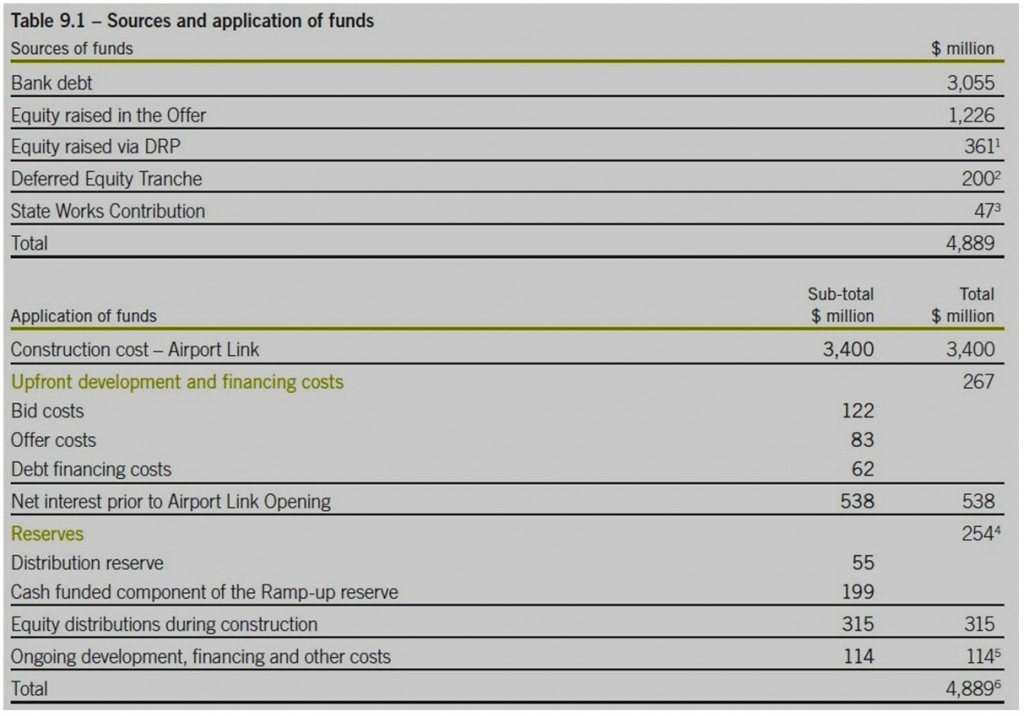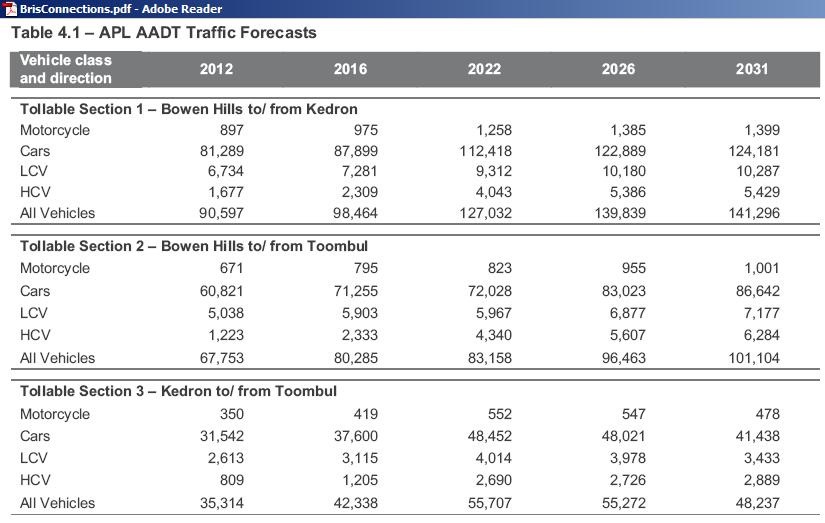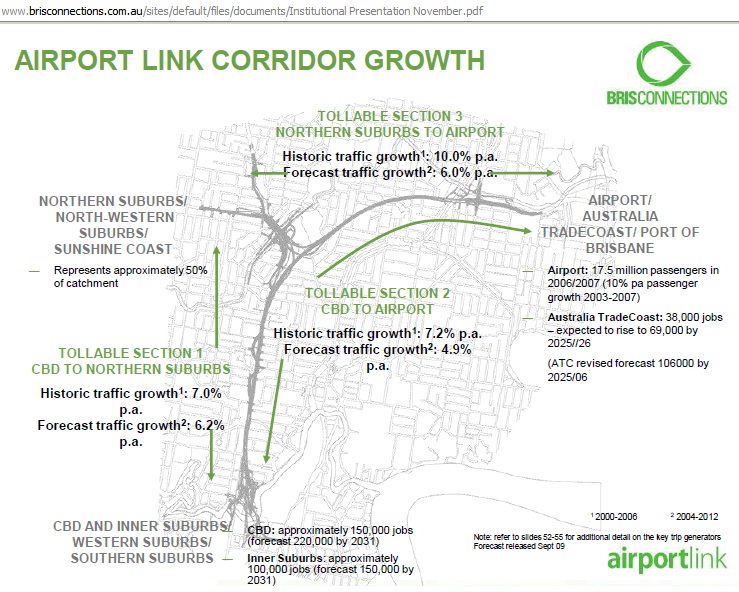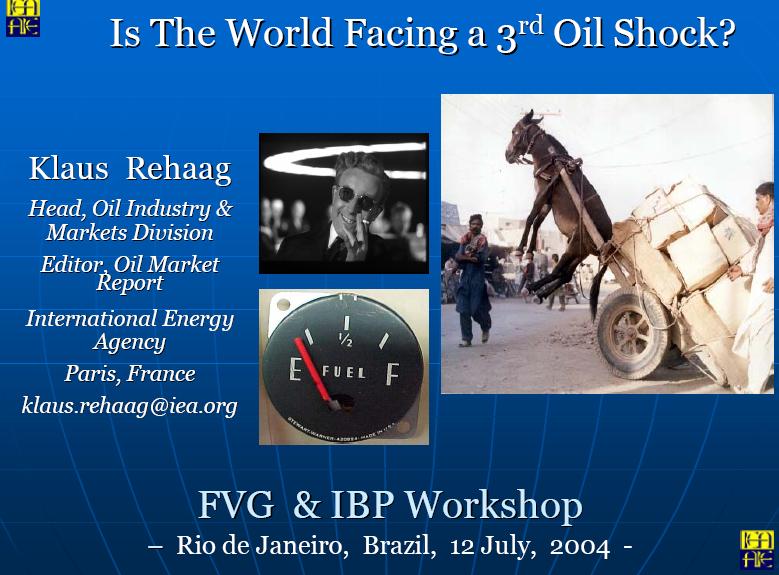Summary
Brisconnections’ Airport Link is based on a financing model with increasing debt until 2026 and repayment of debt only after 2035. In the context of the evolving debt crisis – which was triggered by peak oil – there is no chance that this business is viable.
We start with this article as introduction:
Airport Link will miss forecasts
29/6/2012
INVESTORS expect that BrisConnections’ $5.6 billion Airport Link will ”miss by a long way” ambitious traffic forecasts, despite it tempting motorists by extending the toll-free period for the Brisbane roadway.
http://www.smh.com.au/business/airport-link-will-miss-forecasts-20120628-21594.html
(1) Toll-road debt higher than construction costs
We all know about the bible story of the miracle of loaves and fishes. But you would not expect this to happen with tollway debt. Yet this was Brisconnections’ plan in 2008, following an example set by River City Motorways which has ended in bankruptcy.
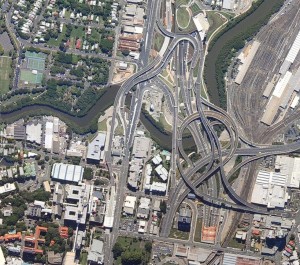 Traffic projections and financing schemes for Brisbane’s road tunnels are as convoluted as this spaghetti interchange between the bankrupt Clem7 tunnel, the Inner City Bypass and the new Airport Link.
Traffic projections and financing schemes for Brisbane’s road tunnels are as convoluted as this spaghetti interchange between the bankrupt Clem7 tunnel, the Inner City Bypass and the new Airport Link.
Let’s have a look at the original PDS (product disclosure statement) dated 3/7/2008, page 88
This table shows the cost and funding of the project
From page 94:
“9.6.5 Refinancing and re-gearing BrisConnections has assumed that the Term Debt Facility will be refinanced with interest only facilities in 2012, 2018, 2024, 2030 and 2035 respectively. This facility is assumed to begin being repaid after June 2035 and to be fully repaid by the end of the Concession Period. It is assumed that the credit margin applicable to the Term Debt Facility shown in table 9.5 will reduce to 0.90% for the first four years of the first refinancing and 0.80% for the remainder of that refinancing and all subsequent refinancings.
The outstanding level of debt is assumed to increase in 2019 and 2026, reflecting increased borrowing capacity as a result of higher expected cash flows from growth in traffic and the inflation indexation of tolls. Debt has been re-sized in these years to maintain a minimum annual interest cover ratio of approximately 1.50x. For further information on the annual interest cover ratio and how it is calculated, refer to Section 9.3.2.”
 Fig 9.2 (page 95) shows debt increasing from $3,273 million in 2012 to $7,736 million in 2026.
Fig 9.2 (page 95) shows debt increasing from $3,273 million in 2012 to $7,736 million in 2026.
“Figure 9.2 represents the profile of BrisConnections outstanding debt contained in the Base Case Financial Model over the Concession Period as set out in the Project Deed. This profile is based on the assumptions set out in Section 9.6 of this PDS including the assumptions as to traffic volumes, Ramp-up, inflation, interest costs, hedging, refinancing, re-gearing, operating costs, administration costs, maintenance costs and capital expenditure. Prospective investors should be aware that the projection of the assumptions in the Base Case Financial Model for an extended period as represented in figure 9.2 is highly uncertain. BrisConnections can give no assurance that the debt profile and underlying cash flow of BrisConnections will be consistent with the representation in the figure. Figure 9.2 is shown for the information of investors only in order to provide further background in relation to the Base Case Financial Model incorporated in the Project Deed and how the outstanding level of debt may vary over the Concession Period”
http://www.investsmart.com.au/distributions/documents/BrisConnections.pdf
(2) Debt paid back after traffic peak?
These are the “ambitious” traffic projections:
Note the bankrupt Clem7 tunnel feeds into the Airport Link from/to the South
Let’s superimpose the traffic projections and the debt profile
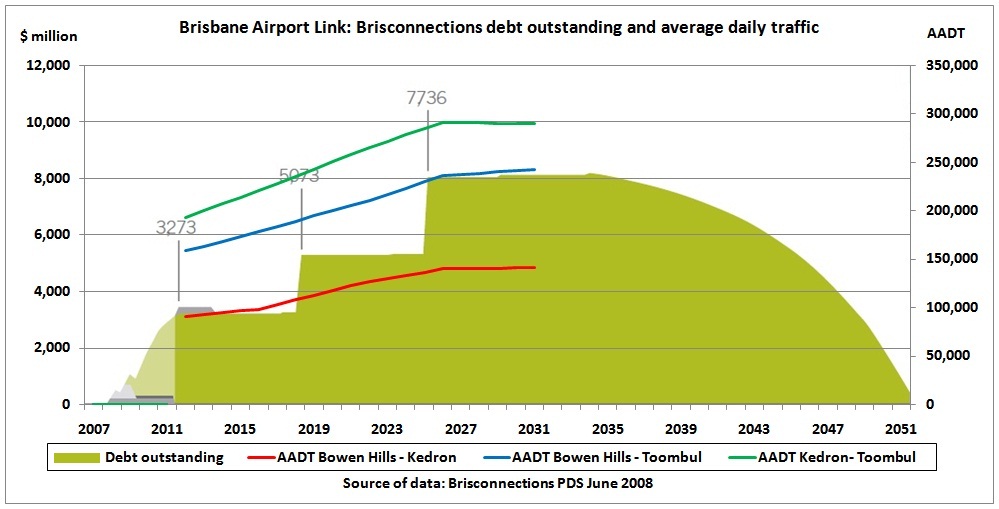 What we see is that traffic is assumed to grow (AADT, right hand side). Despite growing revenue from tolls debt is only paid back 10 years after traffic has reached capacity limits.
What we see is that traffic is assumed to grow (AADT, right hand side). Despite growing revenue from tolls debt is only paid back 10 years after traffic has reached capacity limits.
(3) Historical context of PDS publication
March 2004
Transpex – 5 road tunnels for Brisbane
TransApex is a proposed network of five tolled road tunnels, including three river crossings, linking inner-suburbs of Brisbane. The purpose of TransApex is to alleviate Brisbane’s inexorably worsening traffic congestion.
TransApex was the centrepiece of a transport policy promoted by successful Liberal Lord Mayoral candidate, Campbell Newman, during the campaign for the Brisbane City Council election held on 27 March 2004. It is widely acknowledged that the election result was strongly influenced by this bold plan to respond to widespread frustration regarding worsening traffic congestion and perceived inaction by all levels of government.
http://www.racq.com.au/__data/assets/pdf_file/0010/8992/Policy_TransApex.pdf
July 2004
First IEA warnings
http://www-personal.umich.edu/~twod/oil-ns/articles/research-oil/iea_3rd_oil_shock_kr_rio_2004.pdf
May 2005
Matt Simmons published his book “Twilight in the desert, the coming Saudi oil shock and the world economy”
http://www.worldenergysource.com/articles/pdf/simmons_WE_v8n2.pdf
February 2006
Submission 127 of Geoscience Australia to the Senate Inquiry on oil supplies
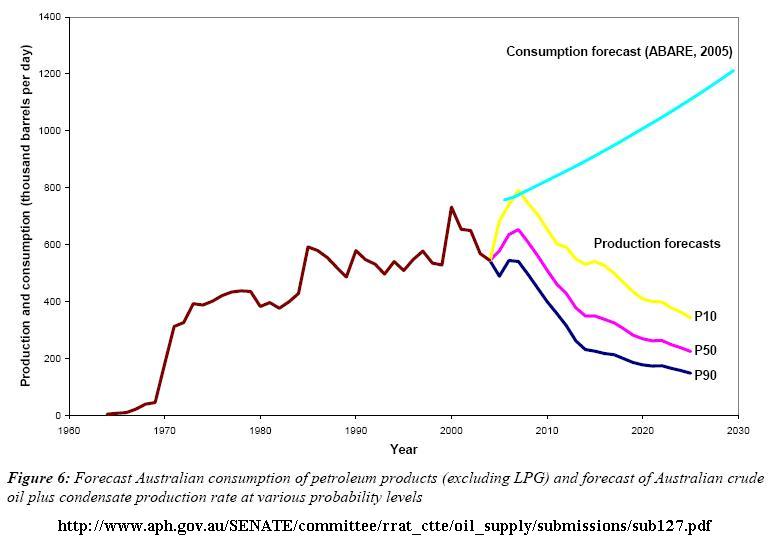 http://www.aph.gov.au/SENATE/committee/rrat_ctte/oil_supply/submissions/sub127.pdf
http://www.aph.gov.au/SENATE/committee/rrat_ctte/oil_supply/submissions/sub127.pdf
Despite these and many other warnings:
October 2006
EIS for the Airport Link
http://www.airportlinkeis.com/OtherLinks/EIS/volume1.htm
October 2007
The Queensland government published a report
Queensland’s oil vulnerability to rising oil prices
“The Taskforce concludes that Queensland’s vulnerability to peaking of world oil supplies, and to world supply disruptions, is particularly acute given our oil supply and demand trends, as well as our regionally distributed population and industrial base.
The Taskforce concludes that the alternative energy sources currently available have a combination of problems including volume constraints, substitution impacts, infrastructure costs and substantially higher costs than existing oil-based liquid fuel supplies”.
http://www.energybulletin.net/node/35638
The draft report from April 2007 is still available here:
Also in October 2007, statistical evidence was clearly showing that crude oil production was in decline
Together with Gail the Actuary I wrote this article in the Oildrum:
“Did Katrina Hide the Real Peak in World Oil Production? and Other Oil Supply Insights”
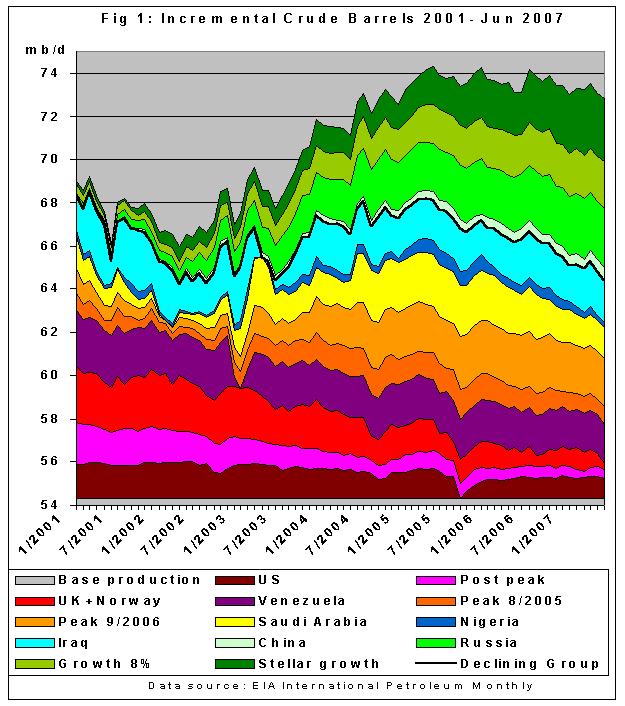 http://www.theoildrum.com/node/3052/
http://www.theoildrum.com/node/3052/
So Matt Simmons’ prediction about declining Saudi oil production had materialized and oil prices went sky-high.
7 June 2008
Oil price soars as US woes mount
The price of oil has made a record jump to nearly $139 a barrel, amid reports it could reach $150 by July because of rising demand and political tension.
http://news.bbc.co.uk/2/hi/7440536.stm
July 2008
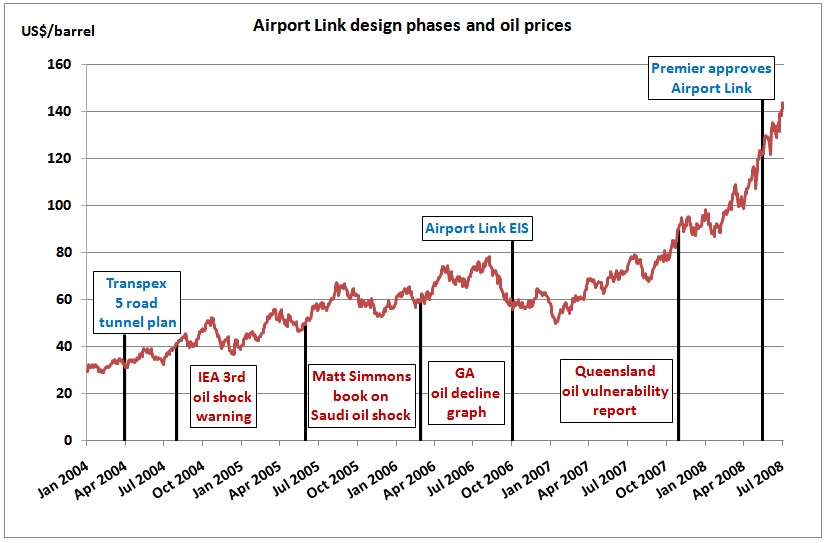 In this moment of high tension, and in the context of repeated warnings, Brisconnections dared to go on the money market and invited investors to acquire 408.67 million stapled units of $3 in 3 instalments at $1 each. This arrangement will later create a lot of confusion, tears and court proceedings.
In this moment of high tension, and in the context of repeated warnings, Brisconnections dared to go on the money market and invited investors to acquire 408.67 million stapled units of $3 in 3 instalments at $1 each. This arrangement will later create a lot of confusion, tears and court proceedings.
The fine print in the PDS contains a fairly standard disclaimer clause:
“Capital and Investment Returns Are Not Guaranteed. Investments in Stapled Units are not deposits with, or liabilities of, any entity and are subject to investment risk, including possible delays in repayment and loss of income and capital invested. Neither BCMCL nor any member of BrisConnections nor any other person guarantees any particular rate of return on the Stapled Units or the performance of BrisConnections, nor do they guarantee the repayment of capital from BrisConnections.” (p. 2)
But this is more specific:
“Returns to Unitholders during the Operations Phase will mainly be a function of the volume of traffic using AirportLink and the level of tolls. Traffic volumes are directly and indirectly affected by a number of factors, including among other things, general traffic levels in the area, the quality and proximity of alternative roads and other transport infrastructure, toll rates and fuel prices.
The impact of a significant and sustained increase in fuel prices on traffic volumes is a risk that should also be considered. Increased fuel prices may lead to a reduction in car ownership, car utilisation and a shift in modal share to public transport, walking, cycling or motorbikes and scooters.” (p. 60)
If these were the risks then one wonders why that project was started at all. And no mention in the whole document of the 100% risk of peak oil
Only days after the PDS was out:
10/7/2008
Sydney petrol price skyrockets
The price of petrol has skyrocketed to record highs overnight, with some Sydney service stations selling unleaded fuel for 173.9 cents a litre.
http://www.smh.com.au/news/national/sydney-petrol-prices-skyrocket/2008/07/09/1215282927997.html
(4) Lessons learnt the hard way by Clem7 tunnel
The lesson how toll rates and fuel prices impact on road tunnels was learnt 2 years later when the Clem7 tunnel opened.
Without tolls, traffic was 50,000 a day but that dropped to 20,000 when a toll of $2.95 was introduced. Tolls were then discounted to $2 and traffic increased to a maximum of 28,000. But when tolls were increased to $3.15, traffic went down again. X’mas and floods in January did not help.
In May 2012 traffic was 21,600 a day
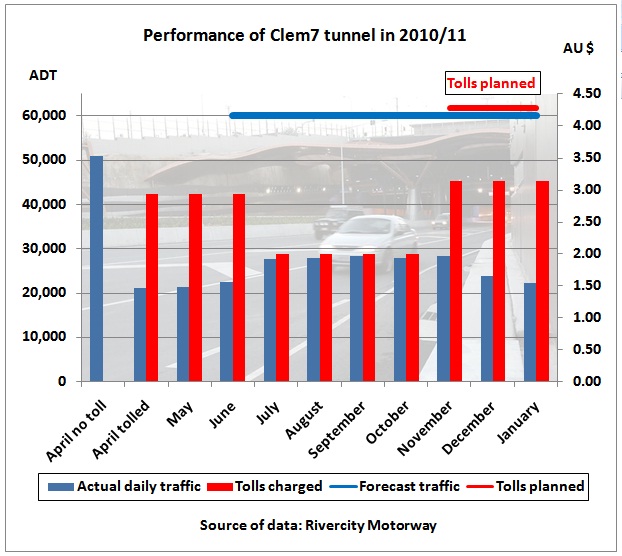 http://www.rivercitymotorway.com.au/content/22342/CLEM7-Traffic-Volumes
http://www.rivercitymotorway.com.au/content/22342/CLEM7-Traffic-Volumes
Conclusion
The Clem7 tunnel feeds traffic into the Airport Link. So it will be interesting indeed to see what is going to happen when the Airport Link opens.
But the long term outlook is more important. A business which – in the best of times – runs on a financing model where revenues are not sufficient to pay back debt for more than 25 years, is not viable. Peak oil has made things worse. First, it triggered the debt crisis which makes it hard for toll-way operators to continue with debt funding and/or roll-over debt. Share markets have become volatile. Secondly, high fuel prices have reduced the purchasing power of motorists and thereby the willingness to pay tolls. A third impact of peak oil will be a generally slowing economy which will arrive in Australia when the mining boom slows.
Outlook
The previous road tunnel failures (links below) do not seem to stop governments from persuing yet more projects in Sydney
F3-M2 road tunnel
Connecting the F3 to M2 – Fixing Sydney’s Missing Link
http://nsroc.com.au/connecting-the-f3-to-m2-fixing-sydneys-missing-link
Abbott promises M4 East
http://www.smh.com.au/opinion/political-news/abbott-promises-m4-east-20120629-2180u.html
Related links:
28/2/2011 Brisbane’s Clem7 tunnel in receivership
http://crudeoilpeak.info/brisbanes-clem7-road-tunnel-in-receivership
http://crudeoilpeak.info/i-told-you-so/north-south-bypass-tunnel-clem7-brisbane
27/1/2010 Peak oil brought forward moment of truth for Lane Cove Tunnel
http://crudeoilpeak.info/peak-oil-brought-forward-moment-of-truth-for-lane-cove-tunnel http://crudeoilpeak.info/lane-cove-tunnel
8/1/2006 How Cross City Tunnel Planners ignored peak oil
http://www.crudeoilpeak.com/?p=219
